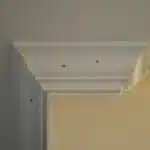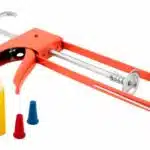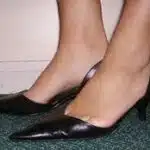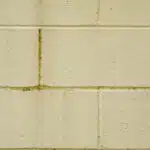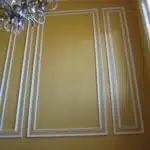Trim carpentry is a crucial aspect of interior design that adds an elegant touch to any room. Installing quarter-round or shoe molding trim is one of the simplest and cost-effective ways to enhance the appearance of your home. Quarter-round molding, also known as base shoe molding, is used to cover gaps between flooring and baseboards. It provides a smooth transition from floor to wall and protects the edges from damage.
Installing quarter-round or shoe molding trim may seem like a daunting task, but with the right tools and techniques, it can be done quickly and efficiently. In this article, we will guide you through the step-by-step process of installing quarter-round or shoe molding trim. From measuring and cutting to nailing and painting, you will learn everything you need to know about this essential aspect of carpentry. Whether you are a DIY enthusiast or a professional carpenter looking for new tips, this article will help you achieve flawless results that will impress your clients or guests.
Understanding The Purpose Of Quarter-Round And Shoe Molding Trim
Quarter-round and shoe molding trim are two types of trim that can be used to add a finishing touch to baseboards, casings, and other architectural elements. They are both small strips of wood or composite material that are installed at the bottom of the wall where it meets the floor. The purpose of quarter-round and shoe molding trim is to cover up gaps between the baseboard and flooring, as well as to protect the baseboard from damage.
One of the benefits of using quarter-round and shoe molding trim is that they help to create a polished look in any room. Without these finishing touches, the space may appear unfinished or unprofessional. Additionally, they can also help to hide imperfections in the flooring or walls by covering up gaps or uneven surfaces. Quarter-round and shoe molding trim can also add depth and visual interest to a room without being too overwhelming.
While quarter-round and shoe molding trim may appear similar at first glance, there are some differences between them. Quarter-round has a more rounded profile than shoe molding, which has a flat back and a slightly curved front edge. Shoe molding is typically used with thicker baseboards, while quarter-round is better suited for thinner profiles. It’s important to choose the right type of trim based on your specific needs and preferences for your project.
Choosing The Right Materials
Once you have understood the purpose of quarter-round and shoe molding trim, it is time to choose the right materials for your project. In this section, we will be comparing different materials available in the market and their cost comparison. This knowledge will help you make an informed decision regarding which material is best suited for your needs.
Comparing materials is crucial because each type has its advantages and disadvantages. For example, if you are looking for a durable option that can withstand moisture, then PVC trim would be ideal. However, if you want a more natural look, then wood would be a better option. Similarly, MDF (Medium Density Fiberboard) is a popular choice due to its affordability and ease of installation. It is also essential to consider your budget before deciding on the material as there can be significant price differences between them.
Cost comparison is another aspect that plays a vital role in selecting the right material. While some materials may seem expensive at first glance, they may save you money in the long run due to their durability and maintenance-free nature. On the other hand, cheaper options may require frequent replacements or repairs, ultimately costing more over time. Therefore, it is essential to weigh both factors when making your decision.
Now that we have compared different materials and their cost implications let’s move on to measuring the area where quarter-round or shoe molding trim needs to be installed. This step requires accuracy as any error could result in waste of material or an uneven finish. The next section will guide you through this process with simple yet effective techniques so that you can achieve a professional-looking result without any hassle.
Measuring The Area
Accurate measurement is crucial when installing quarter-round or shoe molding trim. This will ensure that the trim fits perfectly and there are no unsightly gaps or overlaps. To achieve measuring accuracy, you need to have the right tools at hand.
Here are the necessary tools needed for measuring:
- Measuring tape: This tool is essential for getting accurate measurements of the length of the wall where you want to install the trim.
- Miter saw: A miter saw is used to cut the quarter-round or shoe molding trim accurately at a 45-degree angle, ensuring a tight fit against adjacent walls.
- Pencil: You will need a pencil to mark precise measurements on the trim before cutting it.
- Level: The level is vital in ensuring that your cuts are straight and even.
Before beginning any installation process, make sure that you have all these tools in your toolbox. With these tools, measuring and cutting will be much more manageable and more accurate. The next section will cover how to prep the surface before installing quarter-round or shoe molding trim.
Prepping The Surface
Accurately measuring the surface is paramount to ensure the correct fit of the trim. Cleaning the surface prior to installation will ensure the trim pieces adhere properly, as well as give a better visual presentation. A dust cloth and a vacuum cleaner can be used to rid the surface of any debris and dust. A damp cloth is also recommended for cleaning the surface to remove any oils or grease.
Measuring The Surface
Before installing quarter-round or shoe molding trim, it’s essential to prepare the surface by measuring it accurately. Marking corners and measuring irregular shapes will help you determine the exact length of molding required for each section. Start by measuring the length of each wall, adding them up to determine the total length needed for the entire room.
Next, measure any areas that require special attention, such as corners or curves. To mark corners, use a carpenter’s square to make sure they are at a 90-degree angle. Measuring irregular shapes requires taking multiple measurements along the curve and then using those measurements to create a straight line that fits snugly against the wall. Be sure to add a few inches to each measurement to account for any cutting errors or changes in direction.
Once you have measured all sections of the room, transfer those measurements onto your molding using a pencil. Double-check your markings before making any cuts with your saw. Proper measuring ensures that your quarter-round or shoe molding trim will fit seamlessly against walls and corners, giving your room a professional finish that is both aesthetically pleasing and functional.
Cleaning The Surface
Surface preparation is an essential aspect of any carpentry or trim carpentry project, and it involves several steps that must be followed to ensure a professional and polished finish. One crucial step in surface preparation is cleaning the surface where the quarter-round or shoe molding trim will be installed. This process involves removing any dirt, dust, or debris that may have accumulated on the wall or floor to ensure proper adhesion of the molding.
Proper taping techniques are necessary during the cleaning process to prevent damage to other surfaces in the room. Use painter’s tape to cover baseboards, walls, and floors adjacent to the area where you will be working. Covering these surfaces with tape protects them from scratches, marks, and other damages that may occur during cleaning or installation. Additionally, this technique ensures cleaner lines between the molding and wall or floor edges.
Cleaning the surface also involves removing any old caulk or paint residue that may interfere with proper adhesion of the quarter-round or shoe molding trim. Use a scraper tool to remove old caulking and sandpaper to remove any rough patches on walls or floors. Once all debris has been removed from the surface, wipe it down with a damp cloth to remove dust particles before installing your trim. Proper surface preparation ensures that your quarter-round or shoe molding trim adheres correctly, resulting in a professional finish for your room.
Cutting The Molding
Cutting Techniques: When it comes to cutting quarter-round or shoe molding trim, there are various techniques that a carpenter can use. One technique is using a miter saw, which allows for precise and angled cuts. Another technique is using a coping saw, which allows for intricate cuts around corners and curves. Additionally, a handsaw can be used if the carpenter prefers a more traditional approach.
Safety Precautions: Regardless of the cutting technique used, safety precautions must be taken to prevent accidents or injuries. It is important to wear protective gear such as safety glasses and gloves. Also, ensure that the work area is clear of any obstacles that could cause tripping or slipping hazards. Finally, make sure that the saw blade is properly secured and sharp to prevent it from binding during cuts.
Transition: Now that we have discussed cutting techniques and safety precautions when working with quarter-round or shoe molding trim, we can move on to installing the molding itself.
Installing The Molding
After cutting the molding to fit the desired length, it’s time to install it. The first step in installing quarter-round or shoe molding trim is ensuring that the surface where you plan to install it is clean and free of debris. Common mistakes when installing this type of trim include not filling nail holes properly or failing to sand rough spots before painting.
To install quarter-round or shoe molding trim, you’ll need a few basic tools, including a miter saw, coping saw, measuring tape, hammer, and finishing nails. A nail gun can also be used but should be handled with caution as it can be dangerous if not used correctly. Before starting the installation process, double-check that you have all necessary tools on hand.
When using a nail gun for installation, it’s important to use proper safety precautions such as wearing eye protection and keeping your fingers away from the trigger until ready to fire. Once you’re ready to begin installation, place the molding in position and use finishing nails or a nail gun to secure it in place. Be sure to space out nails evenly along the length of the molding for best results.
Using A Nail Gun
Did you know that the use of a nail gun can reduce construction time by up to 60 percent compared to traditional hammer and nail methods? However, as with any power tool, safety is of utmost importance when using a nail gun. Before operating a nail gun, it is important to read the manufacturer’s instructions thoroughly and wear appropriate safety gear such as eye protection and earplugs.
To ensure precision when using a nail gun for quarter-round or shoe molding trim installation, there are several best practices to follow. First, make sure the nail gun is properly loaded with the correct size of nails. Second, hold the trim firmly in place before firing the nail gun. Finally, aim for the center of the trim piece to avoid splitting or damaging it.
Nail gun safety and precision aren’t just important for getting the job done right – they’re also crucial for maintaining a professional appearance. Using these best practices will help you achieve an even and polished look for your quarter-round or shoe molding trim installation. In the next section, we’ll cover how to fill any nail holes left behind in this process.
Filling Nail Holes
Once the quarter-round or shoe molding trim has been installed, the next step is to fill nail holes. This is an important step in achieving a polished and professional finish. There are various hole filler options available, including wood putty, spackling paste, and caulk.
Wood putty is a popular choice for filling nail holes in wood trim. It is easy to use and comes in a variety of colors to match the color of the trim. Simply apply a small amount of putty to the hole using a putty knife or your finger, then smooth it out and let it dry. Once dried, sand with fine-grit sandpaper until smooth.
Spackling paste and caulk are also effective options for filling nail holes. Spackling paste is ideal for larger holes as it can be molded to fit the shape of the hole. Caulk is best used for gaps between the trim and wall or floor. Whichever option you choose, make sure to follow proper sanding technique once dry to achieve a seamless finish before painting or staining.
Transition: Now that you have filled all nail holes with your preferred option, it’s time to move on to sanding the trim itself for an even smoother finish.
Sanding The Trim
As a carpenter, sanding the trim is an important step in creating a smooth and polished finish. Different types of sandpaper can be used to achieve this goal. Coarse sandpaper helps to remove any rough spots or imperfections in the surface, while finer grits are used to create a smooth finish. It’s important to note that sanding should always be done with the grain of the wood for best results.
To begin the sanding process, start with a coarse grit sandpaper and work your way up to finer grits. Sand in a circular motion, making sure to apply even pressure across the entire surface. Once you’ve achieved a smooth finish with your finer grit sandpapers, wipe down the trim with a clean cloth to remove any dust or debris.
When it comes to achieving a professional-looking finish, proper sanding techniques are crucial. Take your time and be patient as you work through each step of the process. This attention to detail will pay off in the end with beautiful results that will make your quarter-round or shoe molding trim look its best. Next, we’ll move on to caulking the edges for an even more polished look.
Caulking The Edges
Applying caulk is an important step in installing quarter-round or shoe molding trim. It helps seal the gaps between the wall and the trim, preventing air drafts and moisture from seeping in. Before applying caulk, ensure that the surface is clean and dry. Remove any dust, debris, or old caulking using a putty knife or scraper.
To apply caulk, load it into a caulking gun and cut off the tip at a 45-degree angle. Apply a steady pressure on the trigger and move along the gap between the wall and the trim. Use a wet finger or caulk smoothing tool to smooth out any excess caulk and create a neat finish. Allow the caulk to dry completely before painting or staining.
Finishing touches are crucial to achieving a professional-looking installation. Inspect all areas for any gaps, nail holes, or imperfections that need to be filled with wood filler. Sand down any rough edges or surfaces until they are smooth to touch. Once you’ve completed these steps, your quarter-round or shoe molding trim is ready for painting or staining.
Transition: Now that you have applied caulk and done all necessary finishing touches, it’s time to move on to painting or staining the trim.
Painting Or Staining The Trim
After caulking the edges, it’s time to install the quarter-round or shoe molding trim. To provide a visual example, let’s say we’re installing quarter-round trim around the baseboards of a living room. First, measure the length of each wall and cut the molding at a 45-degree angle using a miter saw. Next, use a nail gun or finishing nails to attach the molding to the baseboard and floor, ensuring that it lines up evenly with no gaps.
When it comes to painting or staining the trim, there are several options to consider. Brushing is a traditional method that provides greater control over where and how much paint is applied. On the other hand, spray painting can be faster and more efficient for larger areas but may require more preparation in terms of masking off surrounding surfaces. Additionally, you’ll want to decide whether to use gloss or matte finish based on personal preference and overall aesthetic.
Once you’ve finished painting or staining the trim, it’s important to clean up any excess paint or debris before moving on to the next step. This can include wiping down surfaces with a damp cloth, vacuuming up dust and debris, and properly disposing of any used materials such as brushes or rags. By taking these extra steps to ensure a clean workspace, you’ll not only maintain your tools and equipment but also create a safer environment for yourself and others involved in the project.
Cleaning Up
After completing the installation of quarter-round or shoe molding trim, it’s important to take the time to clean up properly. This not only ensures a professional finish but also helps prevent any accidents or injuries caused by leftover debris.
Tools needed for cleaning up include a broom, dustpan, vacuum cleaner, and a damp cloth. Begin by sweeping the area around the newly installed trim to remove any sawdust, wood chips, or other debris. Use the dustpan to collect the debris and dispose of it properly. Next, use a vacuum cleaner with a brush attachment to remove any remaining dust or dirt from the floor and surrounding areas. Finish by wiping down the trim and adjacent surfaces with a damp cloth to remove any residue.
Proper disposal is crucial when cleaning up after installing quarter-round or shoe molding trim. Sawdust and other small debris should be disposed of in a sealed container and taken out with regular trash. Larger scraps of wood can be saved for future projects or disposed of at a local recycling center. It’s important to avoid leaving any debris on the ground as this can create tripping hazards or damage flooring surfaces.
Transition: While cleaning up after installing quarter-round or shoe molding trim is crucial for safety and aesthetics, sometimes issues arise during installation that require troubleshooting techniques. In the next section, we’ll cover common problems that may occur during installation and how to address them effectively.
Troubleshooting Common Issues
Now that the area is clean and ready, it’s time to install the quarter-round or shoe molding trim. This step is crucial in giving your flooring a professional finish. The quarter-round or shoe molding trim helps cover any gaps between the floor and the baseboard, creating a seamless look.
Before starting, ensure you have all the necessary tools such as measuring tape, saw, coping saw or miter saw, nail gun or hammer, finishing nails or brads, wood filler, sandpaper and paint or stain if desired. Measure each section of wall where the trim will be placed before cutting. Common mistakes include not measuring accurately and not making precise cuts which can lead to overlapping pieces and uneven edges.
Troubleshooting tips for this step include using a coping saw to cut inside corners of the trim to ensure a tight fit with no gaps. If using a miter saw for outside corners, be sure to angle the blade correctly based on the corner’s degree measurement. For an added touch of professionalism, fill any gaps with wood filler before sanding down and painting or staining. With these tools needed and preparation steps taken care of, you’ll be able to achieve a polished finished look in no time.
Tips and tricks for a professional finish include selecting the right size of molding that complements your room’s style and design. Consider painting or staining your trim before installation for easier application without risking damage to your flooring. Another tip is to use finishing nails instead of brads for added durability and strength. By following these steps closely and incorporating these tips, you’ll have a flawless looking floor in no time!
Tips And Tricks For A Professional Finish
Now that the quarter-round or shoe molding trim is installed, it’s time for the finishing touches to give your project a professional look. One common mistake people make is not filling in any gaps or nail holes with wood filler before painting or staining. This can leave the finished product looking uneven and unpolished. So, take the time to fill in any gaps and holes with wood filler, let it dry completely, and then sand smooth before applying paint or stain.
Another common mistake is not using proper tools to cut and install the trim. A good quality saw and miter box will ensure clean cuts and precise angles, which will result in a more polished look overall. Additionally, make sure to use a level when installing the trim to avoid any crooked lines or uneven surfaces.
Lastly, don’t forget about the area where the trim meets at corners. This is where many people struggle to achieve a seamless look. To get a professional finish at corners, use a coping saw to cut away excess material from one piece of molding so that it fits snugly against the other piece without leaving any gaps. With these tips in mind, you’ll be well on your way to achieving a beautifully trimmed space.
Remember, attention to detail is key when it comes to installing quarter-round or shoe molding trim. Taking care of common mistakes such as filling in gaps and using proper tools will make all the difference in achieving a professional finish. With just a little bit of extra effort put into this final stage of your project, you can enjoy a beautifully trimmed space for years to come.
Conclusion: Enjoy Your Beautifully Trimmed Space!
Once you have successfully installed quarter-round or shoe molding trim, it is important to maintain and clean it over time. This will ensure that the trim remains in good condition and continues to enhance the aesthetics of your space. Here are some tips on how to maintain and clean your trim:
- Use a soft cloth or sponge and warm soapy water to wipe down the trim regularly.
- Avoid using abrasive cleaners or harsh chemicals as they can damage the finish of the trim.
- If you notice any scratches or dents on the trim, touch them up with matching paint or stain.
While installing quarter-round or shoe molding trim can be a DIY project, there are benefits of hiring a professional carpenter or trim carpenter for this task. A professional can offer expertise in selecting the right type of molding for your space, ensuring precise measurements and cutting, and properly sealing any gaps between the wall and floor. Additionally, professionals have access to specialized tools and equipment that may not be available to homeowners.
In conclusion, installing quarter-round or shoe molding trim can greatly enhance the look of your space. With proper maintenance and cleaning, your newly installed trim can continue to serve its purpose for years to come. Consider hiring a professional if you want to ensure optimal results for this project.
Conclusion
Quarter-round and shoe molding trim may seem like small details, but they can make a huge difference in the appearance of any room. As a carpenter or trim carpenter, it is essential to understand the purpose of these moldings, choosing the right materials, measuring the area correctly and prepping the surface before installation.
Cutting the molding can be tricky, but with some practice and attention to detail, you can achieve a professional look. Cleaning up after installation is crucial to ensure that your work looks neat and tidy. Don’t worry if you encounter some common issues during installation; we’ve got troubleshooting tips to help you out.
To finish like a pro, use our tips and tricks for achieving a flawless finish that will make your work stand out. When you’re done installing quarter-round or shoe molding trim, take a moment to appreciate how it has transformed your space. With these skills in hand, you’ll be able to tackle any future projects with confidence!
Image Credits
- “Cased openings with transoms” by The Finishing Company Richmond Va (featured)


